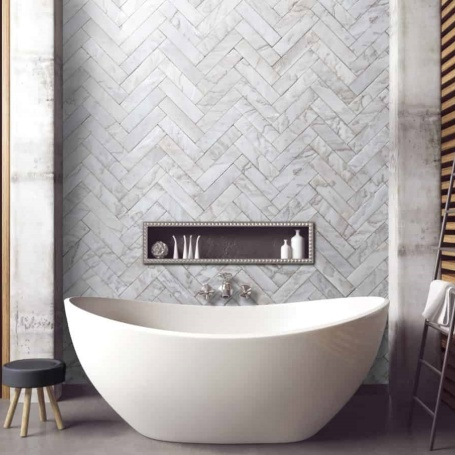
From Limestone to Travertine: The Beauty and Care of Stone Wall Tiles
January 8, 2024
Stone wall tiles offer a touch of nature and elegance to the spaces they adorn. Not only are they aesthetically pleasing, but they also promise durability and a unique character, given the natural variations inherent to real stone. If you’re considering incorporating stone tiles into an interior design project, understanding the wide variety available and their best application can help in making an informed decision. Let’s dive into the world of these timeless materials.
Exploring the Types of Stone Wall Tiles

Stone tiles can be broadly categorized based on the type of stone and the finishes they come in. Here are some of the popular choices:
- Marble Tiles:
Characteristics: Marble is known for its luxurious appeal, veined patterns, and soft colors.
Best for: Kitchen backsplashes and bathroom backsplashes and walls for a touch of opulence.
- Granite Tiles:
Characteristics: A robust and dense stone, granite is recognized for its speckled appearance and wide variety of colors.
Best for: Kitchens and baths due to its durability and resistance to stains.
- Slate Tiles:
Characteristics: Rustic in its appeal, slate tiles come in a range of earthy tones and are known for their textured, layered appearance.
Best for: Fireplaces, patios, and exterior applications as they can withstand varying temperatures.
- Limestone Tiles:
Characteristics: Limestone tiles often have a honed finish and exhibit fossilized patterns.
Best for: Bathrooms, kitchens, and exterior uses for a natural, earthy feel.
- Travertine Tiles:
Characteristics: With pitted holes and troughs in its surface, travertine has a unique, weathered appearance.
Best for: Bathrooms, kitchens, and around pool areas. It offers a timeless, ancient appeal reminiscent of Roman architecture.
Stone Tile Finishes: The Final Touch

The type of finish on a natural stone wall tile can alter its appearance and texture significantly. Here are some common finishes:
- Polished: This finish gives the stone a glossy, mirror-like appearance, emphasizing the color and veins of the stone. Perfect for living rooms and hallway floors.
- Honed: Producing a matte, smooth surface, honed tiles are ideal for kitchen and bathroom backsplashes.
- Flamed: This finish is achieved by exposing the stone to intense heat, causing the surface to burst and become rough. Ideal for outdoor spaces for its slip-resistant properties.
- Tumbled: These tiles have rounded edges and a soft surface, giving them an antique look. They work well in vintage-themed spaces or as decorative borders.
Factors to Consider When Choosing Stone Tiles

- Location: Some stones, like slate, are better suited for outdoor use, while delicate stones like marble may be better for interiors.
- Maintenance: Stones like granite are relatively low maintenance, while porous stones like limestone may require regular sealing.
- Cost: Natural stone tiles can be an investment. Consider your budget, but also remember that the highest quality stone tiles can increase the value and appeal of your home.
Don’t hesitate to mix and match different types of stone tiles for a layered, textured effect. For instance:
- Using granite as a primary tile for a kitchen backsplash with surrounding stone borders can juxtapose the durability of granite with the luxury of a stone like marble in a contemporary design.
- Slate in the living room combined with a travertine fireplace can create a cozy, rustic ambience.
Stone wall tiles are a versatile and sophisticated choice for any home. By understanding the wide range of tiles available and their best uses, you can enhance the beauty of your space in a way that not only complements your aesthetic but also ensures longevity and functionality. Whether it’s the sheer luxury of marble or the rugged charm of slate, stone tiles promise to transform any space they grace.
Have you recently invested in natural stone tile in your kitchen or bath remodel? It’s an elegant choice that lends a touch of nature and timeless beauty to any space. Yet, like anything of value, these tiles require specific care to maintain their appeal. We’re here to guide you through the essential steps in preserving the natural splendor of your stone tiles.
Natural stone, despite its tough appearance, is a porous material. That means it can absorb liquids, which might lead to stains or damage if not treated properly. Fear not, with our comprehensive guide on how to care for natural stone tile, your floors and walls will look pristine for years to come!
Why is Caring for Natural Stone Tile so Crucial?
Natural stone tiles, be it granite, marble, or slate, have unique characteristics. These stones, while durable, are susceptible to wear and tear, especially in high traffic areas. Neglecting them can lead to a dull appearance, and worse, irreversible damage.
But with the right care, these tiles can be a lifelong investment. Their natural patterns and textures are unmatched, and by maintaining them properly, you ensure that they remain a standout feature in your space.
Understanding Your Stone: The First Step in Care

Each type of stone has its quirks. Before diving into general care tips, it’s vital to understand what kind of stone you’re dealing with.
- Granite: Known for its durability and resistance to scratches.
- Marble: Beautiful but can be susceptible to stains, especially from acidic substances.
- Slate: Naturally textured but can flake if not sealed properly.
Knowing the type helps tailor your care routine, ensuring longevity and vibrance.
Daily Maintenance: Keeping Your Tiles Spotless
Daily maintenance is simpler than it sounds. For natural stone wall tiles, it mostly involves keeping them clean from dust and immediate spills. Why is this important? Dust can act as an abrasive, gradually wearing down the surface, especially in high traffic areas.
Here are two easy ways for daily cleaning:
- Use a soft broom or dry mop for floors.
- Wipe countertops and walls with a soft cloth.
Avoid using vinegar or any acidic cleaners as they can etch the surface, especially on marble.
Dealing with Spills: A Quick Response is Key
No matter how cautious we are, spills are inevitable. Especially for kitchen countertops or bathroom walls. The quicker you address these mishaps, the less likely they are to stain or damage your tiles.
Here’s a quick spill response:
- Blot the spill with a paper towel or cloth. Don’t rub as it can spread the spill.
- Clean the area with a mild detergent and water, then rinse.
- Dry it with a soft cloth to prevent water spots.
Sealants: The Protective Shield
Sealants are a natural stone tile’s best friend. They provide a protective layer, guarding your tiles from stains and potential damage. We recommend sealing your tiles every one to two years, but it can vary depending on the stone and its location.
For example:
- Kitchen countertops might need more frequent sealing due to exposure to oils and acids.
- Bathroom tiles can benefit from sealants that offer mold resistance.
Addressing Stains: Gentle Yet Effective Methods
If you spot a stain, don’t panic. Most stains on natural stone tiles can be dealt with at home, using simple methods. Identify the source of the stain first. Organic stains (like coffee) can be lightened using hydrogen peroxide. For oil-based stains, a baking soda poultice might work wonders. Remember, always test any method on a small, inconspicuous area first.
Avoiding Common Mistakes: What Not to Do
In your quest to care for your natural stone tile, it’s crucial to know the don’ts as much as the dos. Here are common mistakes to steer clear of:
- Avoid acidic cleaners: They can damage the stone, especially marble.
- Never use abrasive pads: They can scratch and dull the surface.
- Avoid excessive water: Especially on floors, as it can seep in and cause damage.
Stone Wall Tiles FAQs:
- How often should I clean my natural stone tiles? Regular daily cleaning with a soft broom or cloth is ideal. For deep cleaning, once a week should suffice, using a mild detergent and water.
- How do I care for natural stone tile in high traffic areas? For areas with high foot traffic, daily cleaning is essential. Using protective rugs or mats can also reduce wear. Regular sealing is crucial to prevent deep-seated dirt and stains.
- Is it okay to use generic floor cleaners for stone tiles? It’s always safer to use products specifically designed for natural stone. Generic cleaners might contain ingredients that can damage the stone.
- Can I use a vacuum cleaner on my stone floors? Yes, but ensure the vacuum is on “hard floor” mode to avoid scratching the surface. A soft brush attachment is ideal.